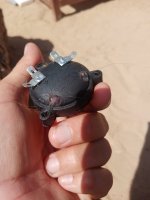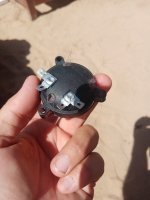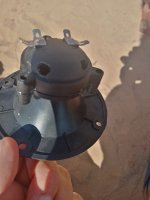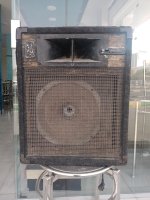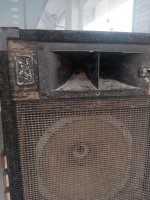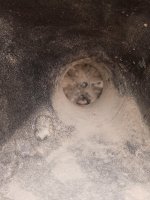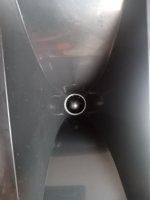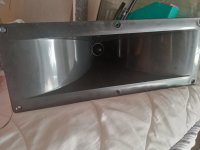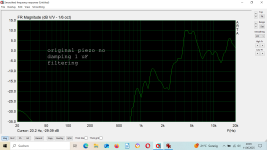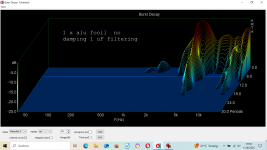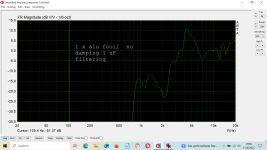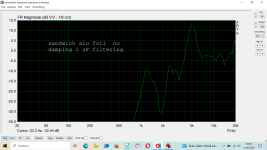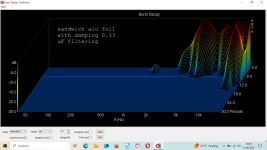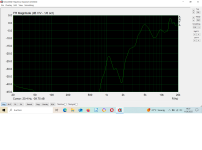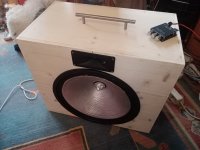https://www.google.com/search?q=son...uMaAHtokBsgcIMC40LjE3LjG4B58n&sclient=gws-wizHowever I use indirect radiating tweeters for fullranges and here there is definitely one turn of phase to be auditioned which one sounds better.
I did a similar thing as @Freedom666 ,but used acrylic model paint instead of tinfoil. I think the important thing is to add damping behind the cone. I used fiberglass which gave good results and took away some edginess. They are OK for pro sound where weight is a factor, and as others have said, they are good as super tweeters.
If you do not want to desolder a piezo disc to reach the back cavity of a piezo tweeter for damping it.
Putting holes in it worked out.
Very careful drilling and then stuffing with soft fibers from a drying machine.
Helps the sound alot.
closed it with silicone sealant
Putting holes in it worked out.
Very careful drilling and then stuffing with soft fibers from a drying machine.
Helps the sound alot.
closed it with silicone sealant
Attachments
redone measurements in a smaller no name horn.
Here the piezo drivers fit better into the horn throat with only a small step (better than with the big HL-1018)
Here the piezo drivers fit better into the horn throat with only a small step (better than with the big HL-1018)
Attachments
No name piezo drivers with 90 ohms across plus and minus, 12 ohm in series and 1uF in line (6db filtering).
Only the alu sandwiched and damped piezo drivers have 0.33uF but same resistances.
here original piezo with only filtering no alu foil, no damping

Only the alu sandwiched and damped piezo drivers have 0.33uF but same resistances.
here original piezo with only filtering no alu foil, no damping
Attachments
no name piezo driver sandwich foil and damping and 0.33uF filtering (instead of 1uF)
The better Monacor quality piezo driver did not fit into the horn - I could not screw to the end closing the gap in the throat.
The better Monacor quality piezo driver did not fit into the horn - I could not screw to the end closing the gap in the throat.
Attachments
I redid the measurements because of the wish to have better smoothing, here smoothing was 1/6th instead of 1/24th
The Monacor quality driver has no dip in the 8khz region, so better overall linearity.
The Monacor quality driver has no dip in the 8khz region, so better overall linearity.
I am pretty sure that better filtering and additional linearizing like described before in this thread is a way to go for better sound.
The measurement series were a test to see what happens if mechanical tweaks are applied.
Good frequency response was achieved with a quality piezo driver from Monacor and damping the back cavity and 6db filtering.
Here no typical "piezo tizz" was audible any more. This means that a pretty cheap driver can become much better. Also the typical "piezo attack" gives a lively and "fast" sound to transients.
Pretty possible that abundant stuffing of the piezo back cavity is good and acceptable for home hifi use but for PA use it might be that a heating up piezo disc might be a problem. But with 24 db filtering you are on the secure side!
@norman bates
did you use only 24 db filtering when sliding down lower the crossover frequency? The resonance could be tamed / linearized with a parametric filter it is worth a try. However all these piezo drivers are not usable below 4khz properly due to small displacement. The bigger horns dont really help putting the lower frequencies up in response. Classic driver technology has its advantages as longer cone travel can be a design goal.
I enjoy a lot using 15 inch fullrange driver reaching up to 4khz and let the piezo do the rest. Works pretty well. Side piezo tweeter giving extra highs off the axis. Made them switchable just to hear how its like on and off.
The measurement series were a test to see what happens if mechanical tweaks are applied.
Good frequency response was achieved with a quality piezo driver from Monacor and damping the back cavity and 6db filtering.
Here no typical "piezo tizz" was audible any more. This means that a pretty cheap driver can become much better. Also the typical "piezo attack" gives a lively and "fast" sound to transients.
Pretty possible that abundant stuffing of the piezo back cavity is good and acceptable for home hifi use but for PA use it might be that a heating up piezo disc might be a problem. But with 24 db filtering you are on the secure side!
@norman bates
did you use only 24 db filtering when sliding down lower the crossover frequency? The resonance could be tamed / linearized with a parametric filter it is worth a try. However all these piezo drivers are not usable below 4khz properly due to small displacement. The bigger horns dont really help putting the lower frequencies up in response. Classic driver technology has its advantages as longer cone travel can be a design goal.
I enjoy a lot using 15 inch fullrange driver reaching up to 4khz and let the piezo do the rest. Works pretty well. Side piezo tweeter giving extra highs off the axis. Made them switchable just to hear how its like on and off.
Attachments
Does anyone know is there some theoretical or scientific paper on piezo drivers?
Especially was there any investigation of the transient behaviour of piezo tweeters (in relation to classical dynamic tweeters)?
Ah, before asking I looked myself. There is some literature to be found and studied:
AES piezo electric super tweeter
AES new type of horn for piezo tweeters
https://secure.aes.org/forum/pubs/journal/?elib=2653
PVDF piezo tweeters
https://audioxpress.com/article/high-polymer-film-the-lost-speaker-technology-part-1
on Audioexpress dot com

Especially was there any investigation of the transient behaviour of piezo tweeters (in relation to classical dynamic tweeters)?
Ah, before asking I looked myself. There is some literature to be found and studied:
AES piezo electric super tweeter
AES new type of horn for piezo tweeters
https://secure.aes.org/forum/pubs/journal/?elib=2653
PVDF piezo tweeters
https://audioxpress.com/article/high-polymer-film-the-lost-speaker-technology-part-1
on Audioexpress dot com
Attachments
Reading the AES article from 2000 simple damping of the piezo disc will linearize its response.
Its worth trying some rubber or silicone selant applied to the piezo disc.
They used just the piezo disc as a sound source without a paper cone glued to it like in most piezo tweeters we analyzed.
Conclusion:
It has been reported that piezo-electric loudspeakers are not suitable for Hi-Fi audio products because of the effect
of sharp resonance on sound pressure frequency response. But we have investigated the use of a piezo-electric
element an ultrasonic vibrator, given its high potential for mass production. Additionally we have worked on
controlling its resonance.
The sharp resonance of a piezo-electric element can be optimally suppressed with a cone-shaped resonance
control element. The effect on sound pressure frequency response due to the cavity in front of diaphragm can be
decreased also with cone-shaped resonance control elements. As a result, we have been developed a piezo-electric
super-tweeter suitable for DVD-Audio, due to its ability to reproduce the wide frequency range of 10kHz-100kHz very flatly.

Its worth trying some rubber or silicone selant applied to the piezo disc.
They used just the piezo disc as a sound source without a paper cone glued to it like in most piezo tweeters we analyzed.
Conclusion:
It has been reported that piezo-electric loudspeakers are not suitable for Hi-Fi audio products because of the effect
of sharp resonance on sound pressure frequency response. But we have investigated the use of a piezo-electric
element an ultrasonic vibrator, given its high potential for mass production. Additionally we have worked on
controlling its resonance.
The sharp resonance of a piezo-electric element can be optimally suppressed with a cone-shaped resonance
control element. The effect on sound pressure frequency response due to the cavity in front of diaphragm can be
decreased also with cone-shaped resonance control elements. As a result, we have been developed a piezo-electric
super-tweeter suitable for DVD-Audio, due to its ability to reproduce the wide frequency range of 10kHz-100kHz very flatly.
Audioxpress article on the HD3P piezo tweeter from Audax (the "egg") (mentioning transient behaviour):
The transient ability is outstanding because the HD-3P’s moving mass is approximately 20 times less than a conventional 20-mm dome tweeter, while the directivity is equivalent. The waterfall plots (i.e., 3-D response graphs showing frequency, amplitude, and time) were impressive. The HD-3P was supplied with its own crossover network, which could be adjusted between 4 to 6 kHz. System sensitivity was in the 86-to-94-dB range.
The transient ability is outstanding because the HD-3P’s moving mass is approximately 20 times less than a conventional 20-mm dome tweeter, while the directivity is equivalent. The waterfall plots (i.e., 3-D response graphs showing frequency, amplitude, and time) were impressive. The HD-3P was supplied with its own crossover network, which could be adjusted between 4 to 6 kHz. System sensitivity was in the 86-to-94-dB range.
Finally, bats can enjoy music too!due to its ability to reproduce the wide frequency range of 10kHz-100kHz very flatly.
I remembered I have a pair of piezo horns, salvaged from a Realistic 3-way speaker. Don't know how it sounds, but it might be moddable.

Honestly, any advice from freddy (freddyi) or djk (rip) here or on audioasylum.com is gold on piezos...............
I only used 24db slopes.
Most piezos are pretty bad.
If I remember, the motorola 1188a works, but good luck with the 8khz resonance that is hard to trap out, especially when transformer coupled.................
But that can be pushed down to 2khz I think.
I only used 24db slopes.
Most piezos are pretty bad.
If I remember, the motorola 1188a works, but good luck with the 8khz resonance that is hard to trap out, especially when transformer coupled.................
But that can be pushed down to 2khz I think.
I found that with a 'transformer driven piezo' an inductor across the piezo terminals was imperative and also adds steeper LF roll of + damping of
resonant peaks.
If you find my Thread "A True piezo Super Tweeter" you may find interesting information 🙂
resonant peaks.
If you find my Thread "A True piezo Super Tweeter" you may find interesting information 🙂
- Home
- Loudspeakers
- Multi-Way
- Are Piezo Tweeters frowned upon?
